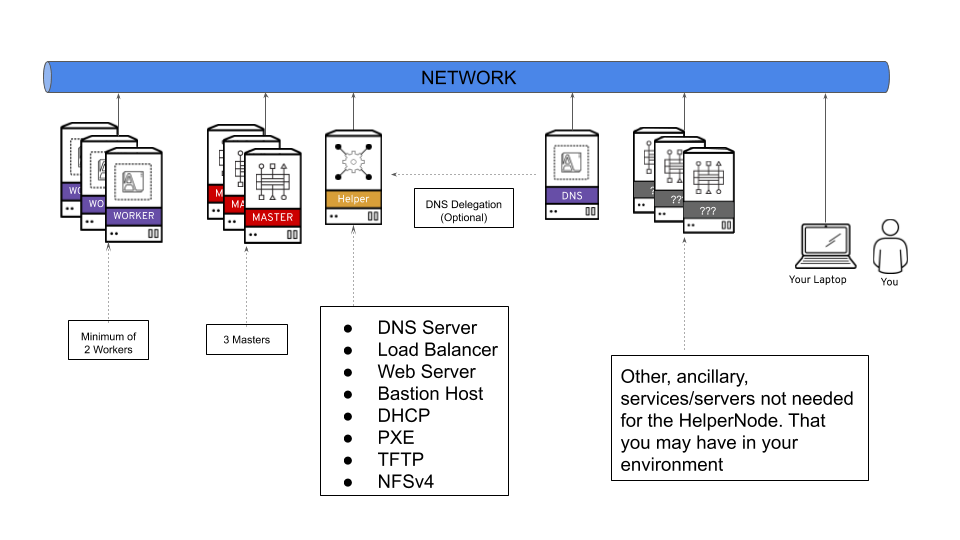❗ Red Hat support cannot assist with problems with this Repo. For issues please open a GitHub issue
This playbook helps set up an "all-in-one" node, that has all the infrastructure/services in order to install OpenShift 4. After you run the playbook, you'll be ready to begin the installation process.
A lot of OpenShift 4 specifc jargon is used throughout this doc, so please visit the official documentation page to get familiar with OpenShift 4.
⚠️ This playbook originally was written with BareMetal UPI install in mind
This playbook assumes the following:
- You're on a Network that has access to the internet.
- The network you're on does NOT have DHCP (you can disable installing DHCP on the helper).
- The ocp4-helpernode will be your LB/DHCP/PXE/DNS and HTTP server.
- You still have to do the OpenShift Install steps by hand.
- I used CentOS 7/8, but RHEL 7/8 will work as well.
- You will be running the
openshift-installcommand from the ocp4-helpernode.
Below is a highlevel diagram how the ocp4-helpernode fits into your network.
It's important to note that you can delegate DNS to this ocp4-helpernode if you don't want to use it as your main DNS server. You will have to delegate $CLUSTERID.$DOMAIN to this helper node.
For example; if you want a $CLUSTERID of ocp4, and you have a $DOMAIN of example.com. Then you will delegate ocp4.example.com to this ocp4-helpernode.
The following are highlevel steps on how to use this playbook. There are more detailed instructions in the "quickstarts" section.
⚠️ NOTE If using RHEL 7, you will need to enable therhel-7-server-rpmsand therhel-7-server-extras-rpmsrepos. If you're using RHEL 8, you will need to enablerhel-8-for-x86_64-baseos-rpms,rhel-8-for-x86_64-appstream-rpms, andansible-2.9-for-rhel-8-x86_64-rpms.
Install a CentOS 7 or CentOS 8 server with this recommended setup:
- 4 vCPUs
- 4 GB of RAM
- 30GB HD
- Static IP
There is a sample kickstart file for EL 7 and EL 8 that is used during testing, if you'd like to automate the initial install of the OS.
Once the base OS is installed, install EPEL
yum -y install https://dl.fedoraproject.org/pub/epel/epel-release-latest-$(rpm -E %rhel).noarch.rpm
Next install ansible and git, then clone this repo.
yum -y install ansible git
git clone https://github.com/RedHatOfficial/ocp4-helpernode
cd ocp4-helpernode
Inside that dir there is a vars.yaml file under docs/examples/var.yaml ... modify it to match your network and the environment. (the example one assumes a /24)
cp docs/examples/vars.yaml .
⚠️ NOTE, currently this playbook assumes/is limited to a/24network
See the vars.yaml documentation page for more info about what you can define. There are different options, depending on what you're doing. For example, if you're doing a static ip install vs a dhcp install.
Once you edited your vars.yaml file; run the playbook
ansible-playbook -e @vars.yaml tasks/main.yml
You can run this script and it's options to display helpful information about the install and other post-install goodies.
/usr/local/bin/helpernodecheck
Now you're ready to follow the OCP4 UPI install doc
The following are quickstarts. These are written using libvirt, but are generic enough to be used in BareMetal or other Virtualized Environments.
- Bare Metal DHCP install quickstart
- Bare Metal Static IPs install quickstart
- Libvirt DHCP install quickstart
- Libvirt Static IPs install quickstart
- DHCP install on KVM/Power quickstart
- DHCP install on PowerVM quickstart
- OCP4 on VMware vSphere UPI Automation quickstart
- A Video "how-to" done on a Twitch Stream
Please see the contributing doc for more details.
